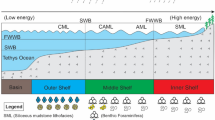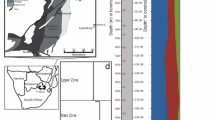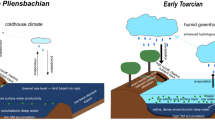Abstract
The lower Cambrian black rock series in eastern Yunnan province is a high-quality shale gas reservoir with great prospect for oil-gas exploration. However, the depositional conditions and mechanisms of organic matter enrichment are not well understood. In this study, geochemical characteristics of total organic carbon (TOC) and major and trace elements of fourteen black rock series samples from Dahai outcrop in eastern Yunnan province are systematically investigated to analyze the paleoenvironment and their effects on organic matter enrichment and established the accumulation model of organic matter. Results show that TOC contents of the four lithologic units of Qiongzhusi Formation black rock series are 0.70, 0.34, 1.77, and 0.27, respectively, which suggests that TOC content is generally low (mean = 0.51%). The main elements show that P2O5, CaO, and MgO are relatively rich, whereas other elements depleted. The enrichment factors (EFs) of trace elements showed that Pb and Zn are highly enriched in all samples, and Cu, Sr, Ba, U, Mo, V, Be, and Mo are also enriched in different lithofacies units. The elemental anomalies may be related to hydrothermal activities, which may lead to the distortion of some paleoenvironmental indicators to some extent. The Rb/Sr and Sr/Cu values show that the palaeoclimate gradually changed from dry to humid. Al concentrations indicate a gradual increase in terrigenous detritus supply. The hydrodynamic conditions and sedimentation rates implied by Zr/Al and Ti/Al values correspond well with lithology and grain size. Based on the comprehensive analysis of B/Ga and Sr/Ba ratios, it is considered that the black rock series in Qiongzhusi Formation was mainly formed in brachial water. Multiple paleoredox indicators (e.g., Ni/Co, V/Cr, U/Th, and V/(V+Ni) ratios) suggest that the sedimentary environment is mainly oxidized, which is usually considered unfavorable for organic matter preservation, and it also forms carbonaceous shale (unit 3) in a dysoxic environment. The Mo/TOC ratios suggest that the sedimentation during Qiongzhusi Formation period was under restricted conditions. The paleoproductivity indicated by P/Ti, Ni/Al and Babio values decreased gradually from medium level to low level. In summary, relatively high paleoproductivity is a prerequisite for organic matter accumulation and less terrigenous debris supply, and relatively arid climate and reductive conditions are favorable for the preservation of organic matter.









Similar content being viewed by others
References
Airo ML, Loukola-Ruskeeniemi K (2004) Characterization of sulfide deposits by airborne magnetic and gamma-ray responses in eastern Finland. Ore Geol Rev 24(1):67–84
Algeo TJ, Lyons TW (2006) Mo-TOC covariation in modern anoxic marine environments: implication for analysis of paleoredox and hydrographic conditions. Paleoceanography 21:1016
Algeo TJ, Maynard JB (2004) Trace-element behavior and redox facies in core shales of Upper Pennsylvanian Kansas-type cyclothems. Chem Geol 206(3):289–318
Algeo TJ, Rowe H (2012) Paleoceanographic applications of trace-metal concentration data. Chem Geol 324-325:6–18
Algeo TJ, Tribovillard N (2009) Environmental analysis of paleoceanographic systems based on molybdenum–uranium covariation. Chem Geol 268(3):211–225
Algeo TJ, Lyons TW, Blakey RC, Over DJ (2007) Hydrographic conditions of the Devono–Carboniferous North American Seaway inferred from sedimentary Mo–TOC relationships. Palaeogeogr Palaeoclimatol Palaeoecol 256(3):204–230
Algeo TJ, Chen ZQ, Fraiser ML, Twitchett RJ (2011) Terrestrial–marine teleconnections in the collapse and rebuilding of Early Triassic marine ecosystems. Palaeogeogr Palaeoclimatol Palaeoecol 308(1):1–11
Bai MG, Zhang C, Yang YR, Dai F, **ong J (2017) The characteristics of shale reservoir from Qiongzhusi formation in lower Cambrian in Qu**g area, eastern Yunnan province, China: a case study of well Quye No.1. J Geom 23(6):838–845
Bilgen S, Sarıkaya İ (2016) New horizon in energy: Shale gas. J Nat Gas Sci Eng 35:637–645
Chang HJ, Chu XL, Feng LJ, Huang J (2012) Progressive oxidation of anoxic and ferruginous deep-water during deposition of the terminal Ediacaran Laobao Formation in South China. Palaeogeogr Palaeoclimatol Palaeoecol 321-322:80–87
Chen J, Wang YJ, Yang C, Liu LW, Ji JF, Lu HY (2000) Rb and Sr geochemical characterization of the Chinese loess stratigraphy and its implications for palaeomonsoon climate. Acta Geol Sin 74(2):279–288
Chen YX, Cui YL, Liao JF, Tian MJ, Jiang YG (2013) Research and ore prospecting problem of the lower Cambrian black series in Yunnan Province, China. Acta Mineral Sin 33(4):637–642
Cheng Y, Chen GD, Yin Q, **a CH, Wang FL, Zhou L, Lu P, Ma L (2017a) Exploration and development status of shale gas in china and enlightenment from North American prosperous shale gas. J Kunming Metall Coll 33(1):16–24
Cheng Y, Guo YF, Chen GD, Yang WL, Wang FL (2017b) On resource potential, distribution and characteristics of shale gas in China. J Kunming Metall Coll 33(5):17–24
Cheng Y, Liu C, Wu W, Wen YM, Nie Q, Lu P (2018a) The application of argon ion polishing-environmental scanning electron microscopy to the research on shale nanometer-sized pores——taking Sha-1 member in JX area as an example. J Chin Electron Microsc Soc 7(1):52–58
Cheng Y, Nie Q, **a JB, Gu HY, Wen YM, Lu P, Liu C (2018b) Formation environment and distribution of organic-rich shales in Yunnan province. Geol Resour 27(6):514–521
Cheng Y, Hu YZ, Li PY, Lu P (2019a) The geochemical characteristics of trace elements and paleoenvironmental evolution of black rock series in the lower Cambrian Qiongzhusi Formation from Huize area, eastern Yunnan province. Contrib Geol Miner Resour Res 34(3):416–422
Cheng Y, Nie Q, Liu C, Wen YM, Lin JF, **a JB (2019b) Silty interlayer /laminae characteristic of Qiongzhusi Formation shale in Kunming area. J Kunming Metall Coll 35(4):29–35
Cheng Y, Tang G, Zhang CY, Zhang XL, Liang XY, Jian L (2020) Restoration of the original organic matter abundance in the highly maturated black rock series: a case study from the lower Cambrian Qiongzhusi Formation in Huize area, eastern Yunnan Province. Miner Explor 12(2):310–317
Cheng Y, Jian L, Tang G, Zhang CY (2021) Trace element anomaly characteristics and metallogenic significance of the lower Cambrian Qiongzhusi Formation from Huize area, eastern Yunnan province. Nonferrous Metals Eng 10(12):90–98
Coveney RM, Pašava J (2004) Diverse connections between ores and organic matter. Ore Geol Rev 24(1):1–5
Deng T, Li Y, Wang ZJ, Yu Q, Dong SL, Yan L, Hu WC, Chen B (2019) Geochemical characteristics and organic matter enrichment mechanism of black shale in the Upper Triassic Xujiahe Formation in the Sichuan basin: implications for paleoweathering, provenance and tectonic setting. Mar Pet Geol 109:698–716
Dong YC, Yan T, Liu HL, Mao Y (2016) Gas-bearing property of shale in lower Cambrian Qiongzhusi Formation, eastern Yunnan province. Nat Gas Explor Dev 39(1):17–22
Dymond J, Suess E, Lyle M (1992) Barium in deep-sea sediment: a geochemical proxy for paleoproductivity. Paleoceanography 7:163–181
Fan DL, Yang XZ, Wang LF, Chen NS (1973) Petrological and geochemical characteristics of a nickel-molybdenum-multe-element-bearing lower-Cambrian black shale from a certain district in south China. Geochimica 3:143–164
Fan DL, Zhang T, Ye J (2004) The black rock series in China and its related mineral deposits. Science Press, Bei**g
Fu CQ, Zhu YM, Chen SB (2015) Diagenesis controlling mechanism of pore characteristics in the Qiongzhusi Formation Shale, East Yunnan. J China Coal Soc 40(S2):439–448
Han SC, Hu K, Cao J (2014) Organic geochemistry of barite deposits hosted in the Early Cambrian black shales from the Tianzhu County, Guizhou Province. Geochimica 43(4):386–398
Huang JL (2011) Resource potential, exploration and development prospect of shale gas in the whole world. Geol Bull China 30(2):324–336
Jia ZB, Hou DJ, Sun DQ, Huang YX (2016) Hydrothermal sedimentary discrimination criteria and its coupling relationship with the source rocks. Nat Gas Geosci 27(6):1025–1034
Jones B, Manning DAC (1994) Comparison of geochemical indices used for the interpretation of palaeoredox conditions in ancient mudstones. Chem Geol 111(1):111–129
Kimura H, Watanabe Y (2001) Ocean anoxia at the Precambrian–Cambrian boundary. Geology 29(11):995–998
Kryc KA, Murray R, Murray DW (2003) Al-to-oxide and Ti-to-organic linkages in biogenic sediment: relationships to paleo-export production and bulk Al/Ti. Earth Planet Sci Lett 211(1-2):125–141
Lan Z, Li X-H, Chu X, Tang G, Yang S, Yang H, Liu H, Jiang T, Wang T (2017) SIMS U-Pb zircon ages and Ni-Mo-PGE geochemistry of the lower Cambrian Niutitang Formation in South China: constraints on Ni-Mo-PGE mineralization and stratigraphic correlations. J Asian Earth Sci 137:141–162
Levresse G, Cheilletz A, Gasquet D, Reisberg L, Deloule E, Marty B, Kyser K (2004) Osmium, sulphur, and helium isotopic results from the giant Neoproterozoic epithermal Imiter silver deposit, Morocco: evidence for a mantle source. Chem Geol 207(1):59–79
Lézin C, Andreu B, Pellenard P, Bouchez J-L, Emmanuel L, Fauré P, Landrein P (2013) Geochemical disturbance and paleoenvironmental changes during the Early Toarcian in NW Europe. Chem Geol 341:1–15
Li A, Wenlong D, Zhang GL, Zhang MQ, Zhang ZX, Yan BZ, Zhou CX, Chen ZZ, Bai P (2016) Reservoir characteristics of marine shale in the Malong block of eastern Yunnan Province and comparison analysis. Earth Sci Front 23(2):176–189
Li H, Chunyan S, Jianqing L (2018) Shale geochemical characteristics and enrichment mechanism of organic matter of Wufeng-Longmaxi formation in the Mabian area of southeast Sichuan basin. J Northeast Pet Univ 42(4):52–65
Liang X, Zhang TS, Yang Y, Zhang Z, Gong QS, Ye X, Zhang JH (2014) Microscopic pore structure and its controlling factors of overmature shale in the Lower Cambrian Qiongzhusi Fm, northern Yunnan and Guizhou provinces of China. Nat Gas Ind 34(2):18–26
Liu W, Yao J, Tong J, Qiao Y, Chen Y (2018) Organic matter accumulation on the Dalong Formation (Upper Permian) in western Hubei, South China: constraints from multiple geochemical proxies and pyrite morphology. Palaeogeogr Palaeoclimatol Palaeoecol 514:677–689
Liu Y, Wu B, Gong Q, Cao H (2019) Geochemical characteristics of the lower Silurian Longmaxi Formation on the Yangtze Platform, South China: implications for depositional environment and accumulation of organic matters. J Asian Earth Sci 184:104003
Mao JW, Lehmann B, Andao D, Guangdi Z, Ma DS, Wang YT, Mingguo Z, Kerrich R (2002) Re-Os dating of polymetallic Ni-Mo-PGE-Au mineralization in lower Cambrian black shales of south China and its geologic significance. Econ Geol 17(5):1535–1547
Meyers PA, Pratt LM, Nagy B (1992) Introduction to geochemistry of metalliferous black shales. Chem Geol 99(1-3):vii–xi
Mort H, Jacquat O, Adatte T, Steinmann P, Föllmi K, Matera V, Berner Z, Stüben D (2007) The Cenomanian/Turonian anoxic event at the Bonarelli level in Italy and Spain: enhanced productivity and/or better preservation? Cretac Res 28(4):597–612
Munteanu M, Marincea S, Kasper HU, Zak K, Alexe V, Trandafir V, Saptefrati G, Mihalache A (2004) Black chert-hosted manganese deposits from the Bistritei Mountains, Eastern Carpathians (Romania): petrography, genesis and metamorphic evolution. Ore Geol Rev 24(1):45–65
Murphy A, Sageman B, Hollander D, Lyons T, Brett C (2000) Black shale deposition and faunal overturn in the Devonian Appalachian Basin: clastic starvation, seasonal water-column mixing, and efficient biolimiting nutrient recycling. Paleoceanography 15(3):280–291
Murray RW, Leinen M (1993) Chemical transport to the seafloor of the equatorial Pacific Ocean across a latitudinal transect at 135 W: tracking sedimentary major, trace, and rare earth element fluxes at the Equator and the Intertropical Convergence Zone. Geochem Cosmochim Acta 57:4141–4163
Nian HL, Cui YL, Meng GH, Jiang YG, Cheng DY, Cai JJ, Ding DS (2015) Ore deposit geology and ore genesis of Canglongshan black shale Mo-Ni polymetallic deposit, Malong City, Yunnan Province, China. Acta Mineral Sin 35(4):430–434
Pagès A, Barnes S, Schmid S, Coveney RM, Schwark L, Liu W, Grice K, Fan H, Wen H (2018) Geochemical investigation of the lower Cambrian mineralised black shales of South China and the late Devonian Nick deposit, Canada. Ore Geol Rev 94:396–413
Pearce C, Cohen A, Coe A, Burton K (2008) Molybdenum isotope evidence for global ocean anoxia coupled with perturbations to the carbon cycle during the Early Jurassic. Geology 36(3):231–234
Pi DH, Liu CQ, Shields-Zhou GA, Jiang SY (2013) Trace and rare earth element geochemistry of black shale and kerogen in the early Cambrian Niutitang Formation in Guizhou province, South China: Constraints for redox environments and origin of metal enrichments. Precambrian Res 225:218–229
Rachold V, Brumsack H-J (2001) Inorganic geochemistry of Albian sediments from the Lower Saxony Basin NW Germany: palaeoenvironmental constraints and orbital cycles. Palaeogeogr Palaeoclimatol Palaeoecol 174(1):121–143
Ross DJK, Bustin RM (2009) Investigating the use of sedimentary geochemical proxies for paleoenvironment interpretation of thermally mature organic-rich strata: examples from the Devonian–Mississippian shales, Western Canadian Sedimentary Basin. Chem Geol 260(1):1–19
Sageman BB, Murphy AE, Werne JP, Ver Straeten CA, Hollander DJ, Lyons TW (2003) A tale of shales: the relative roles of production, decomposition, and dilution in the accumulation of organic-rich strata, Middle–Upper Devonian, Appalachian basin. Chem Geol 195(1):229–273
Schenau SJ, Reichart GJ, De Lange GJ (2005) Phosphorus burial as a function of paleoproductivity and redox conditions in Arabian Sea sediments. Geochem Cosmochim Acta 69(4):919–931
Schoepfer SD, Shen J, Wei H, Tyson RV, Ingall E, Algeo TJ (2015) Total organic carbon, organic phosphorus, and biogenic barium fluxes as proxies for paleomarine productivity. Earth-Sci Rev 149:23–52
Shi CH, Cao J, Han SC, Hu K, Bian LZ, Yao SP (2021) A review of polymetallic mineralization in lower Cambrian black shales in South China: combined effects of seawater, hydrothermal fluids, and biological activity. Palaeogeogr Palaeoclimatol Palaeoecol 561:110073
Soeder DJ (2018) The successful development of gas and oil resources from shales in North America. J Pet Sci Eng 163:399–420
Straub M, Sigman DM, Ren H, Martínez-García A, Meckler AN, Hain MP, Haug GH (2013) Changes in North Atlantic nitrogen fixation controlled by ocean circulation. Nature 501(7466):200–203
Taylor SR, McLennan SM (1985) The continental crust: its composition and evolution. London: Blackwell Scientific Publications
Wang YM, Chen B, Li XJ, Wang H, Chang LC, Jiang S (2018) Sedimentary characteristics of upwelling facies shale in Lower Silurian Longmaxi Formation, northeast Sichuan area. Acta Petrol Sinica 39(10):1092–1102
Wang BL, Li LH, Zeng PS (2004) Basic geophysic characteristics of Sichuan-Yunnan-Guizhou rhombic block and its relationship with endo-mineralization. J. East China Inst Technol Nat Sci 27(4):301–308
Wei GJ, Liu Y, Li XH, Liang XR, Shao L (2003) Excess Al in the sediments from South China Sea. Bull Mineral Petrol Geochem 22(1):23–25
Wei HR, Yang RD, Gao JB, Wang W (2012) Primary study on the sediment structures in black-shale-series deposits of the basal Cambrian, Guizhou province. Geoscience 26(4):673–681
Wu P, Liu SF, Dou GX (2014) Sedimentary response to Emeishan mantle plume in the eastern Yunnan Province. Acta Petrol Sin 30(6):1793–1803
Zhang C, Bao SJ, Shi DS, Hu L, Kun Y (2017a) Geological Conditions for Shale Gas Accumulation and Favorable Area Prediction in Qu**g of Eastern Yunnan. Mar Orig Petrol Geol 22(1):69–74
Zhang CK, Han Q, He L (2018) Structural characteristics and evolution of the **aojiang fault zone in Butuo Area, Sichuan Province. Sichuan Nonferr Metal (2):19–22
Zhang HT, Zhang Y, Zhu YM, Zhang X (2017b) Geological conditions for shale gas accumulation in lower Cambrian Qiongzhusi Formation, Yunnan. China Pet Explor 22(3):88–95
Zhou J, Hu K, Bian LZ, ** YS, Cao J, Song SM (2008) Geochemical characteristics and ore-forming processes of Ni-Mo polymetallic deposits in Lower Cambrian black shale, Zunyi, Guizhou Province. Miner Depos 27(6):742–750
Zou CN, Zhu RK, Chen ZQ, Ogg JG, Wu ST, Dong DZ, Qiu Z, Wang YM, Wang L, Lin SH, Cui JW, Su L, Yang Z (2019) Organic-matter-rich shales of China. Earth-Sci Rev 189:51–78
Funding
This work was financially supported by the Scientific Research Fund of Yunnan Education Department (2020J0771) and the Scientific Research Fund of Kunming Metallurgy College (2019XJZK08).
Author information
Authors and Affiliations
Corresponding authors
Ethics declarations
Conflict of interest
The authors declare that they have no competing interests.
Additional information
Responsible Editor: Attila Ciner
Rights and permissions
About this article
Cite this article
Cheng, Y., Liu, W., Wu, W. et al. Geochemical characteristics of the lower Cambrian Qiongzhusi Formation in Huize area, east Yunnan: implications for paleo-ocean environment and the origin of black rock series. Arab J Geosci 14, 2081 (2021). https://doi.org/10.1007/s12517-021-08433-0
Received:
Accepted:
Published:
DOI: https://doi.org/10.1007/s12517-021-08433-0




